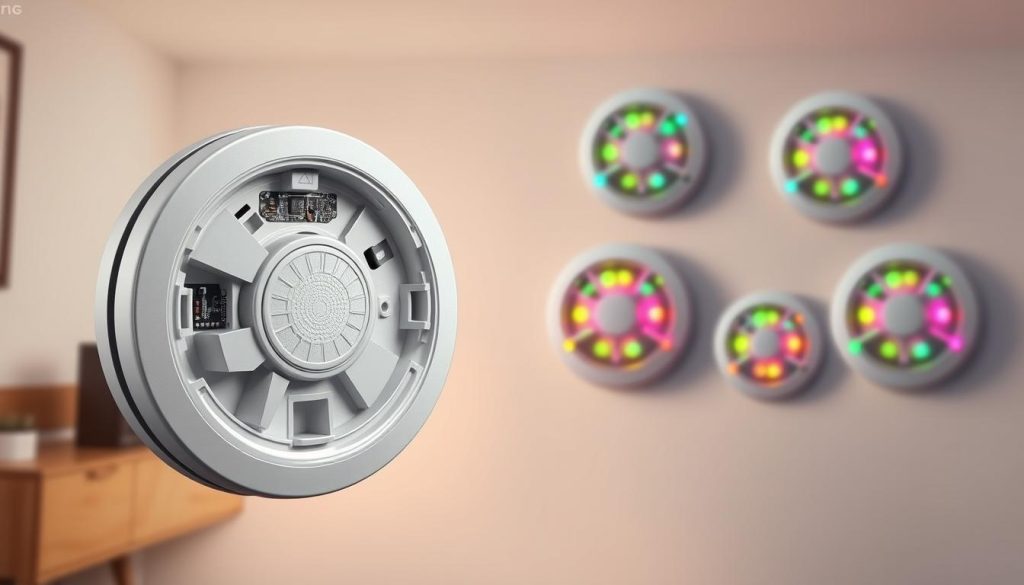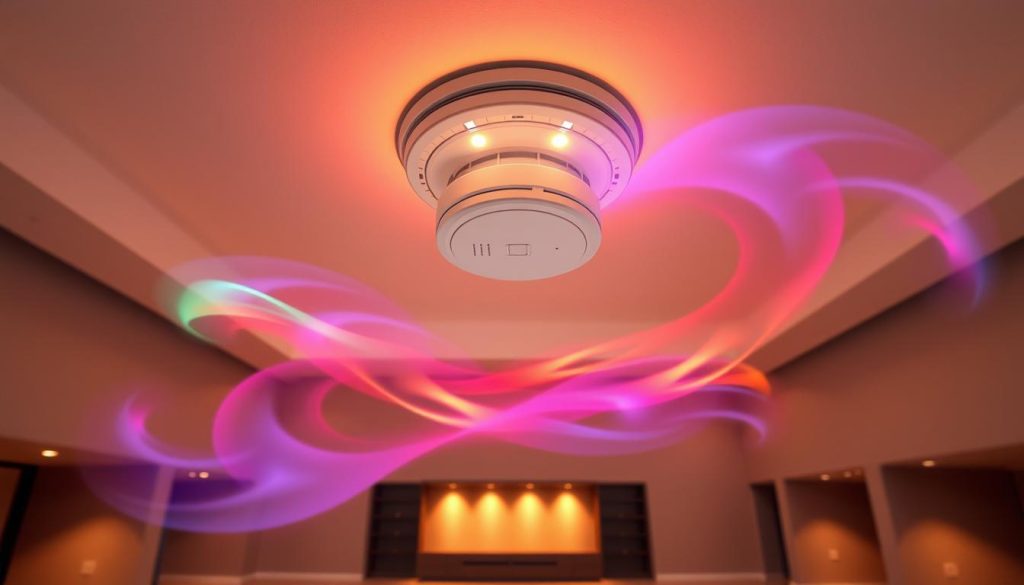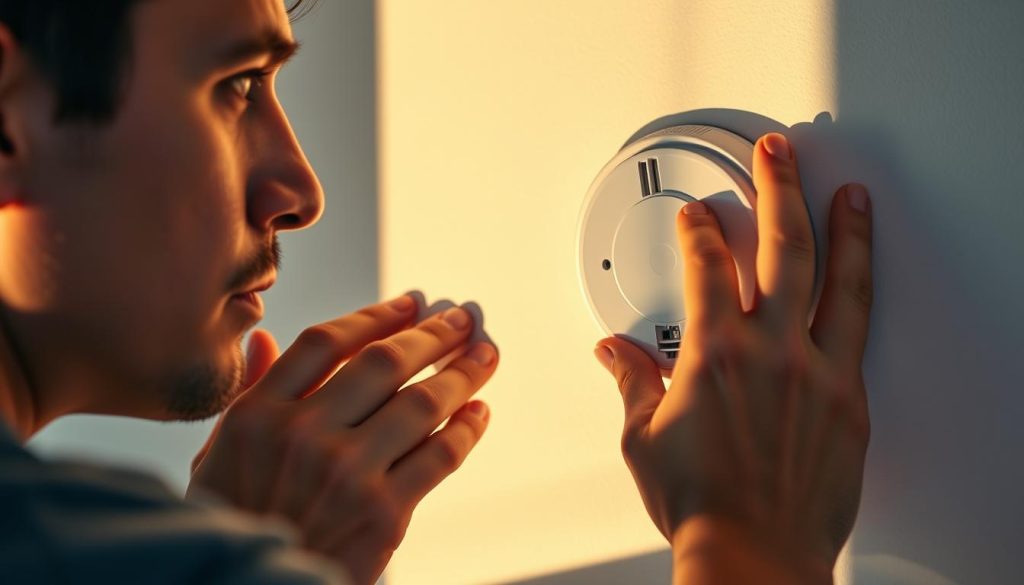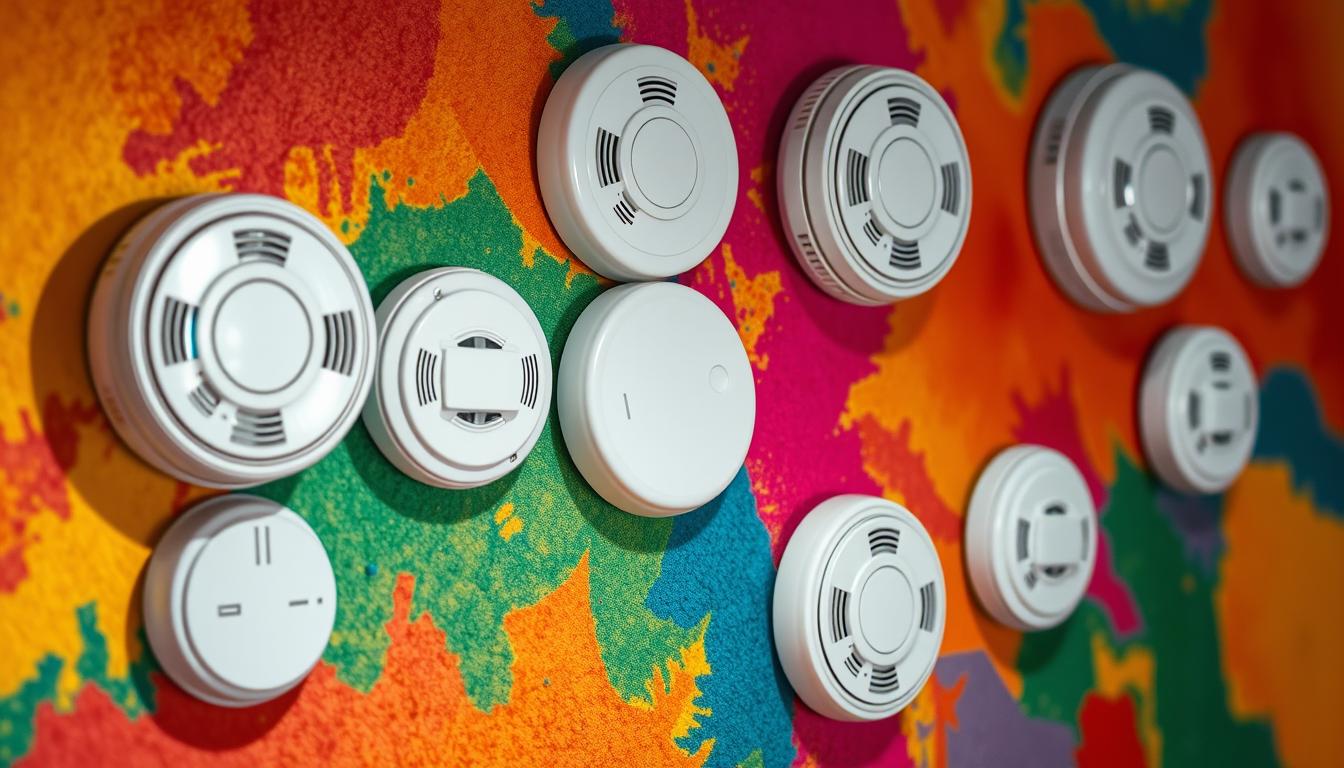Did you know nearly 3 out of 5 home fire deaths occur in properties without functioning alarms? According to the National Fire Protection Association, having working smoke detectors slashes your risk of perishing in a fire by 55%. These unassuming devices use advanced particle detection methods – some even relying on nuclear technology – to safeguard homes and workplaces.
Modern systems act as 24/7 sentinels, analyzing air quality for microscopic threats. When they sense danger, you gain critical escape time – often minutes that mean the difference between survival and tragedy. Their effectiveness stems from decades of engineering breakthroughs that balance sensitivity with accuracy.
Proper placement and maintenance transform these devices into life-saving partners. You’ll want to test them monthly and replace batteries annually. Newer models now differentiate between burnt toast and actual flames, reducing false alarms while maintaining vigilance.
Key Takeaways
- Functional alarms reduce fire death risks by over half
- Advanced detection methods identify threats early
- Proper maintenance ensures optimal performance
- Newer models minimize unnecessary alerts
- Strategic placement maximizes coverage
- Combined technologies enhance reliability
Understanding the Science Behind Smoke Detectors
Your detector’s chirp hides nuclear secrets. These devices use two distinct methods to catch danger: ionization and photoelectric systems. Each responds to different fire types, creating layered protection.

How Ionization Detectors Work
Ionization models contain americium-241, a material that charges air molecules. This creates a steady current between metal plates inside the chamber. When smoke enters, particles attract ions, disrupting the flow. A drop in current triggers the alarm within seconds.
These detectors excel at spotting flaming fires. Fast-moving flames produce tiny, dark particles that easily interfere with the electrical field. You’ll often find them near kitchens or garages where rapid combustion risks exist.
The Role of Photoelectric Sensors
Photoelectric units use light beams to detect threats. A LED shoots light across the chamber, avoiding the sensor during normal conditions. Smoke particles scatter this beam, redirecting light to the detector. Once enough light registers, the alarm sounds.
This technology shines with smoldering fires. Thick smoke from overheated wiring or slow-burning fabrics creates larger particles that reflect light effectively. Place these near bedrooms where smoldering risks are higher.
Combined systems leverage both methods, covering all fire types. They monitor air quality continuously, analyzing particle density and light patterns. This dual approach reduces false alerts while maintaining rapid response times.
The Safety Science of Smoke Detectors
What makes your alarm react faster to different emergencies? Modern systems use specialized methods to catch specific threats. Ionization and photoelectric technologies form the backbone of most residential units, each targeting distinct fire characteristics.

Key Detection Technologies and Their Benefits
Ionization detectors excel at spotting flaming fires. These emergencies produce tiny, dark particles that disrupt electrical currents inside the device. When smoke enters the chamber, it triggers an alarm within seconds – crucial for fast-moving flames near kitchens or garages.
Photoelectric sensors dominate smoldering fire detection. Overheated wiring or slow-burning fabrics create larger, lighter particles. These reflect light beams inside the chamber, activating alerts before flames erupt. You’ll want these near bedrooms where smoldering risks often start.
Dual-sensor alarms merge both technologies, covering all fire types. The NFPA recommends this approach because flaming and smoldering fires emit different particles. Combined systems analyze smoke density and light patterns, reducing false alerts while maintaining rapid response times.
Newer models balance sensitivity with practicality. They ignore burnt toast particles but react instantly to dangerous smoke levels. This precision comes from decades of refining how detectors interpret air quality data, giving you reliable protection without unnecessary interruptions.
Choosing and Installing Your Smoke Detector
Strategic placement transforms ordinary alarms into life-saving networks. Follow these guidelines to create a detection system that works with physics, not against it.

Placement Guidelines for Maximum Protection
Install units on every level of your home, including basements and attics. Place alarms inside each bedroom and directly outside sleeping areas. Smoke rises, so mount detectors high on walls or ceilings – at least 4 inches from corners.
Closed doors block airflow, requiring dual placement. Put detectors on both sides of bedroom doors in multi-story buildings. Avoid kitchens and bathrooms where steam causes false triggers. For vaulted ceilings, position alarms 3 feet below the peak.
| Location | Installation Height | Special Notes |
|---|---|---|
| Bedrooms | Ceiling center | Both sides of doors |
| Hallways | 12″ from ceiling | Every 30 feet |
| Stairwells | Top step | Include basement stairs |
Installation Tips for Battery-Operated and Hardwired Units
For battery-powered alarms, test monthly and replace cells annually. Many fire departments provide free units – contact your local station. Hardwired systems require professional installation but offer constant power when paired with backup batteries.
Choose interconnected alarms that trigger simultaneously. Wireless models sync through radio frequencies, while wired versions use electrical circuits. Avoid placing detectors near HVAC vents or ceiling fans that disperse smoke.
Maintaining and Testing Your Smoke Detector
Time transforms protectors into hazards if ignored. Your alarm’s reliability depends on consistent care – a neglected unit becomes as useless as an empty fire extinguisher. Follow these protocols to keep defenses battle-ready.

Routine Testing and Battery Replacement
Press the test button monthly – this 5-second habit confirms both detection and alert systems work. For 9-volt battery units, swap cells annually. Lithium-powered models last a decade but require full replacement when expired.
Hear chirping? That’s your final warning. Most devices beep when power drops below operational levels. Hardwired alarms still need backup battery checks – test them monthly and replace cells yearly despite the main power source.
Long-Term Maintenance and Replacement Schedules
Mark installation dates on detectors with permanent marker. All units – even hardwired ones – expire after 10 years. Sensor degradation makes older models dangerously slow, regardless of battery status.
Sync maintenance with daylight saving time changes. This rhythm helps remember critical tasks:
- Test alarms first Sunday of March/November
- Replace 9-volt batteries annually
- Upgrade lithium models at decade mark
Keep manufacturer paperwork for warranty claims and replacement guides. Proper care ensures these devices stand guard effectively through their operational lifespan.
Innovations and Future Trends in Smoke Detector Technology
Tomorrow’s alarms might ignore your burnt bacon while spotting real flames faster. Cutting-edge developments now address the delicate balance between sensitivity and practicality, particularly in kitchens where cooking particles often trigger false alerts.
Advances Reducing Nuisance Alarms
New algorithms analyze particle size and movement patterns. Multi-spectrum light beams distinguish between steam from showers and smoke from electrical fires. Some models now use machine learning to recognize common cooking emissions based on air quality changes over time.
Third-generation sensors combine photoelectric and carbon monoxide detection. This dual approach verifies threats by checking for heat patterns and toxic gases. You’ll see fewer alerts from burnt toast while maintaining protection against smoldering couch fires.
New Testing Standards and Safety Improvements
Updated UL 217 requirements now simulate modern fire risks like synthetic materials and open-concept layouts. These tests ensure detectors respond faster to flaming liquids and slower-smoldering upholstery fires that older models might miss.
| Test Type | Old Standard | New Standard | Benefit |
|---|---|---|---|
| Cooking Nuisance | Single smoke source | 6 food burn scenarios | Fewer false alarms |
| Fire Response | 3 fire types | 8 fire scenarios | Faster real alerts |
| Sensor Accuracy | Basic particle count | Size/shape analysis | Better threat ID |
Wireless interconnectivity now allows detectors to share threat data across your property. When one unit spots danger, all alarms sound simultaneously – even if the fire starts in a remote basement corner.
Conclusion
Every second counts when flames erupt. Working alarms slash fire-related death risk by 55%, giving families vital moments to escape. This protection stems from smart engineering – dual-sensor systems combining ionization and photoelectric technologies detect both fast-burning and smoldering threats.
Proper placement turns devices into a coordinated defense network. Install units on every floor, near bedrooms, and away from airflow disruptions. Monthly testing and battery swaps keep systems battle-ready, while decade-long replacement cycles address sensor degradation.
Emerging innovations refine responsiveness while cutting false alerts. Next-gen models analyze particle patterns and sync wirelessly, creating faster, smarter fire protection. Updated safety standards ensure detectors meet modern home layouts and synthetic material risks.
Your choices directly impact lives and property. Pair strategic installation with routine care to maintain peak performance. When smoke appears, these vigilant guardians buy the time needed to react – because in emergencies, early warnings rewrite outcomes.



